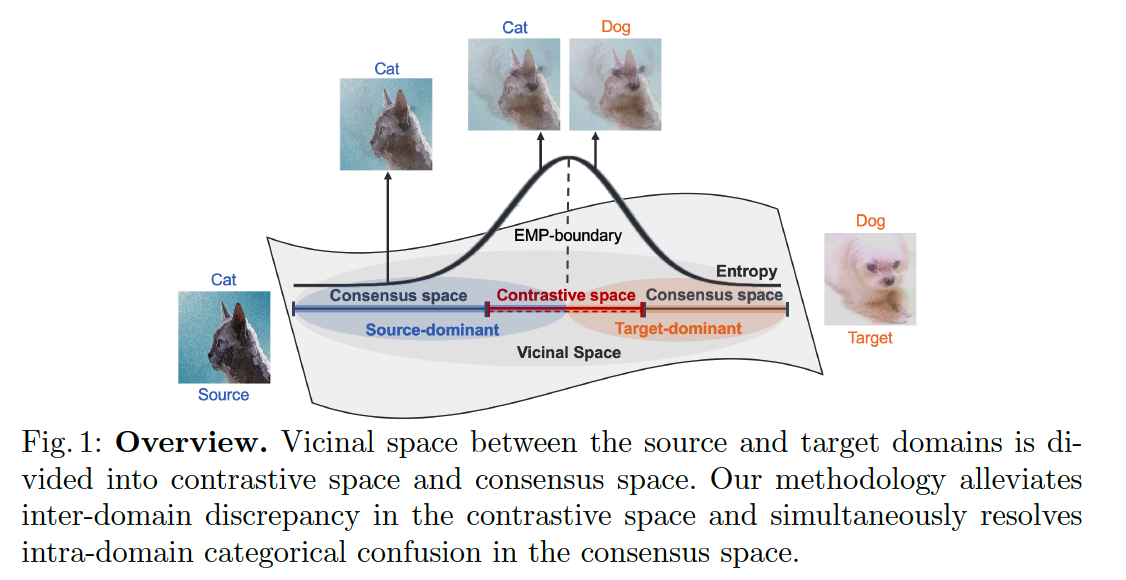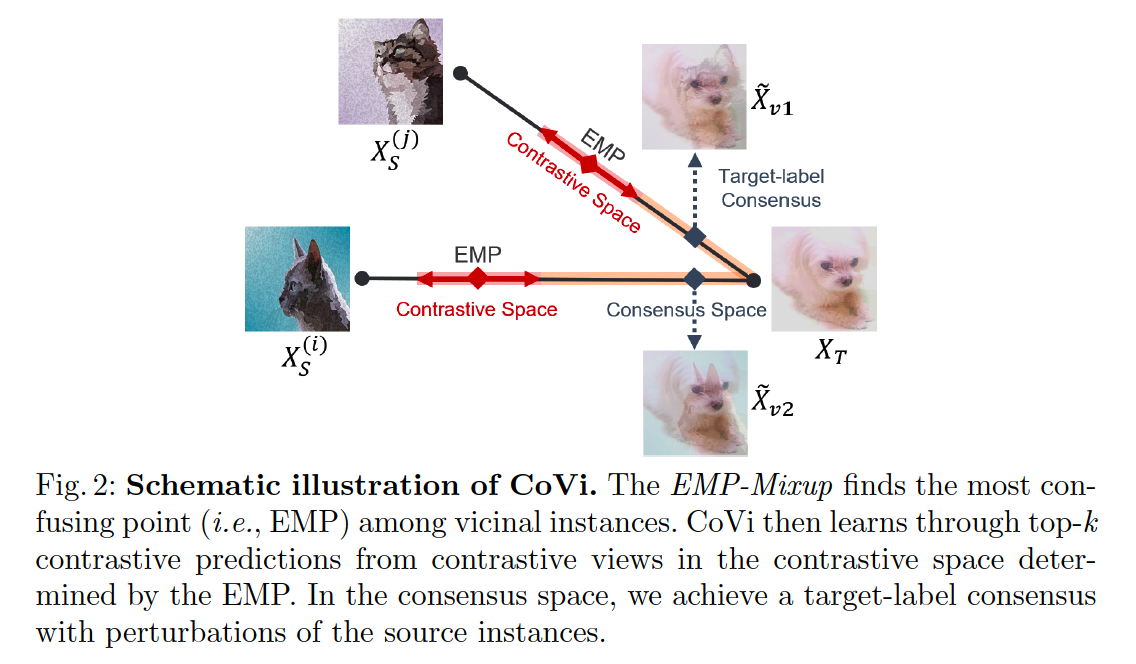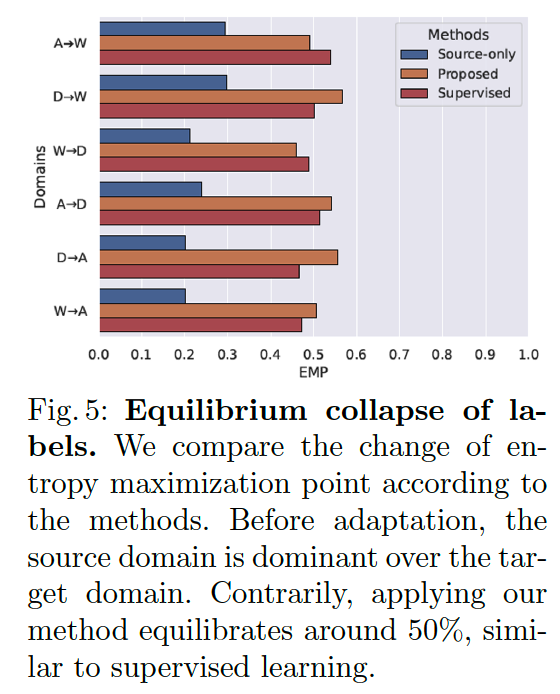Contrastive Vicinal Space for Unsupervised Domain Adaptation
Contents
- Abstract
- Introduction
- UDA
- Consistency Training
- Methodology
- Preliminaries
- EMP-Mixup
- Contrastive Views and Labels
- Label Consensus
0. Abstract
Unsupervised domain adaptation (UDA)
- have utilized ”vicinal” space between source & target domains
Problem : Equilibrium collapse of labels
- SOURCE labels are dominant over the TARGET labels
- happen in the predictions of vicinal instances
Propose an ”Instance-wise” minimax strategy
- minimizes the entropy of HIGH UNCERTAINTY instances in the vicinal space
- divide the vicinal space into 2 subspaces
- (1) contrastive space
- inter-domain discrepancy is mitigated
- by constraining instances to have contrastive views and labels
- (2) consensus space
- reduces the confusion between intra-domain categories
- (1) contrastive space
1. Introduction
(1) UDA (Unsupervised Domain Adaptation)
Idea
- adapt a model trained on (labeled) SOURCE domain
- to (unlabeled) TARGET domain
Problem : domain shift ( distribution shift )
- Arises from the change in data distn ( btw SOURCE & TARGET domain )
Widely used solution :
- leverage intermediate domains btw SOURCE & TARGET
- many approaches have emerged built on data augmentation to construct the intermediate spaces.
- ex) Mixup augmentation to the DA task
- use inter-domain mixup to efficiently overcome the domain shift problem by utilizing vicinal instances between the source and target domains
- ex) Mixup augmentation to the DA task

(2) Consistency Training
- one of the promising components for leveraging UN-labeled data
- enforces a model to produce SIMILAR predictions of original & perturbed instances.
Contrastive Vicinal space-based (CoVi) algorithm
- leverages vicinal instances from the perspective of self-training
- Self-training : approach that uses self-predictions of a model to train itself.
-
In vicinal space : SOURCE label is generally dominant over the TARGET label
- even if vicinal instances consist of a higher proportion of TARGET instances than source instances, their predictions are more likely to be SOURCE labels
\(\rightarrow\) call this problem : equilibrium collapse of labels between vicinal instances
( + entropy of the predictions is maximum at the points where the equilibrium collapse of labels occurs )
Goal : find the point where the entropy is maximized between the vicinal instances
\(\rightarrow\) present EMP-Mixup

<br>
EMP-Mixup
- minimizes the entropy for the entropy maximization point (EMP)
- adaptively adjusts the Mixup ratio
- according to the combinations of source and target instances
- divide the vicinal space into 2 space
- (1) SOURCE-dominant & (2) TARGET-dominant
- using EMP as a boundary (i.e., EMP-boundary)
- vicinal instances of …
- the SOURCE-dominant space : have source labels as their predicted top-1 label.
- the TARGET-dominant space : have target labels as their top-1 label
2 specialized subspaces
( to reduce inter-domain & intra-domain discrepancy )
- contrastive space
- consensus space
a) CONTRASTIVE space
-
to ensure that the vicinal instances have contrastive views :
- SOURCE-dominant views ( ex. 0.7 source + 0.3 target )
- TARGET-dominant views ( ex. 0.3 source + 0.7 target )
\(\rightarrow\) they should have the same top-2 labels containing the source and target labels
-
under our constraints, the two contrastive views have opposite order of the first and second labels in the top-2 labels
-
propose to impose consistency on predictions of the two contrastive views.
-
mitigate INTER_domain discrepancy by solving “swapped prediction” problem
- predict the top-2 labels of a contrastive view from the other contrastive view.
b) CONSENSUS space
- to alleviate the categorical confusion within the intra-domain
- generate TARGET-dominant vicinal instances
- utilizing multiple source instances as a perturbation to a single target instance.
- ex) target 0.7 + source (A) 0.3
- ex) target 0.7 + source (B) 0.3
- role of the source instances ( A, B, … )
- to learn classification information of the source domain (X)
- to confuse the predictions of the target instances (O)
- utilizing multiple source instances as a perturbation to a single target instance.
- can ensure consistent and robust predictions for target instances …
- by enforcing label consensus among the multiple target-dominant vicinal instances to a single target label
2. Methodology
CoVI introduces 3 techniques
leverage the vicinal space btw SOURCE & TARGET domains
- (1) EMP-Mixup
- (2) Contrastive views & labels
- (3) Label-consensus
(1) Preliminaries
Notation
- \(\mathcal{X}\): mini-batch of \(m\)-images, with labels as \(\mathcal{Y}\)
- [ SOURCE ] \(\mathcal{X}_{\mathcal{S}} \subset \mathbb{R}^{m \times i}\) and \(\mathcal{Y}_{\mathcal{S}} \subset\) \(\{0,1\}^{m \times n}\)
- \(n\) : number of classes
- \(i=c \cdot h \cdot w\).
- [ TARGET ] \(\mathcal{X}_{\mathcal{T}} \subset \mathbb{R}^{m \times i}\)
- [ SOURCE ] \(\mathcal{X}_{\mathcal{S}} \subset \mathbb{R}^{m \times i}\) and \(\mathcal{Y}_{\mathcal{S}} \subset\) \(\{0,1\}^{m \times n}\)
- \(\mathcal{Z}\) : extracted features from \(\mathcal{X}\)
Model
consists of the following sub components:
- an encoder \(f_\theta\)
- a classifier \(h_\theta\)
- an EMP-learner \(g_\phi\)
Mixup
Mixup based on the Vicinal Risk Minimization (VRM)
- virtual instances constructed with the linear interpolation of 2 instances
Define the inter-domain Mixup applied between the source and target domains as …
- \(\tilde{\mathcal{X}}_\lambda=\lambda \cdot \mathcal{X}_{\mathcal{S}}+(1-\lambda) \cdot \mathcal{X}_{\mathcal{T}}\).
- \(\tilde{\mathcal{Y}}_\lambda=\lambda \cdot \mathcal{Y}_{\mathcal{S}}+(1-\lambda) \cdot \hat{\mathcal{Y}}_{\mathcal{T}}\).
- \(\hat{\mathcal{Y}}_{\mathcal{T}}\) : pseudo labels of the target instances
Empirical risk for vicinal instances : \(\mathcal{R}_\lambda=\frac{1}{m} \sum_{i=1}^m \mathcal{H}\left[h\left(f\left(\tilde{\mathcal{X}}_\lambda^{(i)}\right)\right), \tilde{\mathcal{Y}}_\lambda^{(i)}\right]\).
(2) EMP-Mixup
2 observiations in the vicinal space
- Observation 1. “The labels of the TARGET domain are relatively recessive to the SOURCE domain labels.”
- Observation 2. “Depending on the convex combinations of source and target instances, the label dominance is changed.”
Observation 1
- investigate the dominance of the predicted top-1 labels between the source and target instances in vicinal instances.
- find that the label dominance is balanced, when the labels of both the source and target domains are provided
- top-1 label = determined by the instance with larger proportion.
- UDA : un-labeled ( the label of the target domain is not given )
- Balance of label dominance is broken (i.e., equilibrium collapse of labels).
- discover that source labels frequently represent vicinal instances even with a higher proportion of target instances than source instances.
Observation 2
- label dominance is altered according to the convex combinations of instances
- implies that an instance-wise approach can be a key to solving the label equilibrium collapse problem
- discover that the entropy of the prediction is maximum at the point where the label dominance changes
- because the source and target instances become most confusing at this point
- aim to capture and mitigate the most confusing points
- vary with the combination of instances
- introduce a minimax strategy to break through the worst-case risk among the vicinal instances
MinMax Strategy
-
minimize the worst risk by finding the entropy maximization point (EMP) among the vicinal instances.
-
to estimate the EMPs, we introduce a small network, \(E M P\)-learner \(g_\phi\)
- aims to generate Mixup ratios that maximize the entropy of the encoder \(f_\theta\) followed by a classifier \(h_\theta\).
Procedure
-
step 1) instance features
- \(\mathcal{Z}_{\mathcal{S}}=f_\theta\left(\mathcal{X}_{\mathcal{S}}\right)\) & \(\mathcal{Z}_{\mathcal{T}}=f_\theta\left(\mathcal{X}_{\mathcal{T}}\right)\)
-
step 2) concatenate
- pass the concatenated features \(\mathcal{Z}_{\mathcal{S}} \oplus \mathcal{Z}_{\mathcal{T}}\) to \(g_\phi\).
-
step 3) produces the entropy maximization ratio \(\lambda^*\)
- maximizes the entropy of the \(f_\theta\)
- Mixup ratios for our EMP-Mixup :
- \(\lambda^*=\underset{\lambda \in[0,1]}{\arg \max } \mathcal{H}\left[h_\theta\left(f_\theta\left(\tilde{\mathcal{X}}_\lambda\right)\right)\right]\), where \(\lambda=g_\phi\left(\mathcal{Z}_{\mathcal{S}} \oplus \mathcal{Z}_{\mathcal{T}}\right)\).
-
step 4) objective function for EMP-learner
-
maximize the entropy :
- \(\mathcal{R}_\lambda(\phi)=\frac{1}{m} \sum_{i=1}^m \mathcal{H}\left[h\left(f\left(\tilde{\mathcal{X}}_\lambda^{(i)}\right)\right)\right]\).
-
only update the parameter \(\phi\) of the EMP-learner
( not \(\theta\) of the encoder and the classifier )
-
-
step 5) EMP-Mixup minimizes the worst-case risk ( on vicinal instances )
- \[\mathcal{R}_{\lambda^*}(\theta)=\frac{1}{m} \sum_{i=1}^m \mathcal{H}\left[h\left(f\left(\tilde{\mathcal{X}}_{\lambda^*}^{(i)}\right)\right), \tilde{\mathcal{Y}}_{\lambda^*}^{(i)}\right]\]
-
\(\lambda^*=\left[\lambda_1, \ldots, \lambda_m\right]\) : has different optimized ratios
-
Overall objective functions : \(\mathcal{R}_{e m p}=\mathcal{R}_{\lambda^*}(\theta)-\mathcal{R}_\lambda(\phi)\)


(3) Contrastive Views and Labels
Observation 3
“The dominant/recessive labels of the vicinal instances are switched at the EMP.”
with the EMP as a boundary (i.e., EMP-boundary)…
-
the dominant/recessive label is switched between the source and target domains
= vicinal instances around the EMP-boundary should have source and target labels as their top-2 labels.
-
divide the vicinal space into …
- (1) source-dominant space
- (2) target-dominant space

source-dominant space
- \(\lambda^*-\omega<\lambda_{s d}<\lambda^*\).
target-dominant space
- \(\lambda^*<\lambda_{t d}<\lambda^*+\omega\).
- \(\omega\) : margin of the ratio from the EMP-boundary
source-dominant instances \(\tilde{\mathcal{X}}_{s d}\) &target dominant instances \(\tilde{\mathcal{X}}_{t d}\) have contrastive views of each other.
focus on the top- 2 labels for each prediction
- only interested in the classes that correspond to the source and target instances, not the other classes.
- define a set of top-2 one-hot labels within a mini-batch as \(\hat{\mathcal{Y}}_{[k=1]}\) and \(\hat{\mathcal{Y}}_{[k=2]}\).
Labels for the instances
-
of TARGET-dominant space : \(\hat{\mathcal{Y}}_{t d}=\lambda_{t d} \cdot \hat{\mathcal{Y}}_{t d[k=1]}+\left(1-\lambda_{t d}\right) \cdot \hat{\mathcal{Y}}_{t d[k=2]}\)
-
of SOURCE-dominant space : \(\hat{\mathcal{Y}}_{s d}=\lambda_{s d} \cdot \hat{\mathcal{Y}}_{s d[k=1]}+\left(1-\lambda_{s d}\right) \cdot \hat{\mathcal{Y}}_{s d[k=2]}\)
propose a new concept of contrastive labels
- constrain the top-2 labels from the contrastive views as follows:
-
\(\hat{\mathcal{Y}}_{s d[k=1]}\) from \(\tilde{\mathcal{X}}_{s d}\) and \(\hat{\mathcal{Y}}_{t d[k=2]}\) from \(\tilde{\mathcal{X}}_{t d}\) must be equal, as the predictions of the SOURCE instances.
-
\(\hat{\mathcal{Y}}_{s d[k=2]}\) must be equal to \(\hat{\mathcal{Y}}_{t d[k=1]}\), as for the predictions of the TARGET instances.
-
solve a “swapped” prediction problem
- enforce consistency to the top-2 contrastive labels obtained from contrastive views of the same source and target instance combinations.
Final objective for our contrastive loss
( in target-dominant space )
- \(\mathcal{R}_{t d}(\theta)=\frac{1}{m} \sum_{i=1}^m \mathcal{H}\left[h\left(f\left(\tilde{\mathcal{X}}_{t d}^{(i)}\right)\right), \hat{\mathcal{Y}}_{t d}^{(i)}\right]\).
- where \(\hat{\mathcal{Y}}_{t d}=\lambda_{t d} \cdot \hat{\mathcal{Y}}_{s d[k=2]}+\left(1-\lambda_{t d}\right) \cdot \hat{\mathcal{Y}}_{s d[k=1]}\).
( in source-dominant space )
- vise vera
\(\rightarrow\) \(\mathcal{R}_{ct} = \mathcal{R}_{t d}(\theta) + \mathcal{R}_{s d}(\theta)\)
(4) Label Consensus
Contrastive & Consensus Space
- contrastive space ) confusion between the source and target instances is crucial
- consensus space ) focus on uncertainty of predictions within the intra-domain than inter-domain instances
Consensus Space
-
exploit multiple source instances to impose perturbations to target predictions
( rather than classification information for the source domain )
-
makes a model more robust to the target predictions
- by enforcing consistent predictions on the target instances even with the source perturbations.
Target-label consensus
step 1) Construct 2 randomly shuffled versions of the source instances within a mini-batch
step 2) Apply Mixup with a single target mini-batch
- obtain two different perturbed views \(v_1\) and \(v_2\)
- mixup ratio = sufficiently small
- since too strong perturbations can impair the target class semantics
step 3) Compute two softmax probabilities from the perturbed instances \(\tilde{\mathcal{X}}_{v_1}\) and \(\tilde{\mathcal{X}}_{v_2}\)
- using an encoder & classifier
step 4) Aggregate the softmax probabilities &yield a one-hot prediction \(\hat{\mathcal{Y}}\).
Assign the label \(\hat{\mathcal{Y}}\) to both versions of the perturbed target-dominant instances \(\tilde{\mathcal{X}}_{v_1}\) and \(\tilde{\mathcal{X}}_{v_2}\).
Imposing consistency to differently perturbed instances for a single target label
= allows us to focus on categorical information for the target domain
Objective for label consensus
\(\mathcal{R}_{c s}(\theta)=\frac{1}{m} \sum_{i=1}^m\left[\mathcal{H}\left(h\left(f\left(\tilde{\mathcal{X}}_{v_1}^{(i)}\right), \hat{\mathcal{Y}}^{(i)}\right)\right)+\mathcal{H}\left(h\left(f\left(\tilde{\mathcal{X}}_{v_2}^{(i)}\right), \hat{\mathcal{Y}}^{(i)}\right)\right)\right]\).
- where \(\mathcal{H}\) is the cross-entropy loss.
